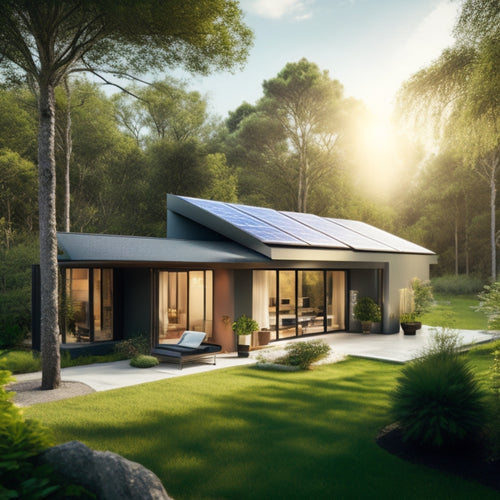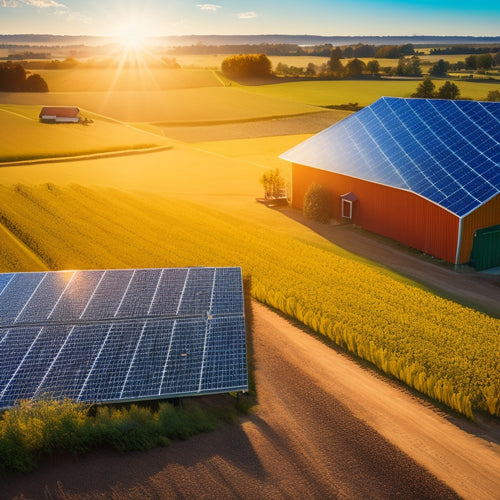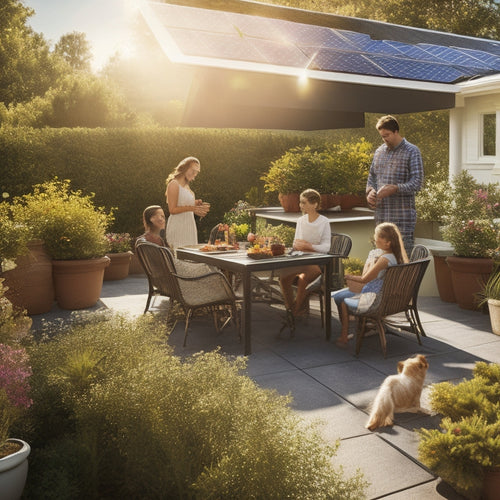
Designing Residential Solar Arrays for Maximum Efficiency
Share
When designing a residential solar array for maximum efficiency, you'll want to assess your roof's size and orientation to determine the ideal panel installation capacity. Choosing high-efficiency solar panels that suit your climate and budget is also vital. Proper array configuration and layout can reduce energy losses, while a thorough shading analysis helps you mitigate obstacles like trees and buildings. By considering these factors and implementing ongoing monitoring and maintenance, you can enhance your energy production by up to 20%. Now, it's time to explore deeper into the details that will help you access your solar array's full potential.
Key Takeaways
- Assess roof size, orientation, and obstructions to determine optimal solar panel installation capacity and energy output.
- Choose high-efficiency solar panels and compatible inverters to maximize energy production and system performance.
- Optimize array configuration and layout by considering panel spacing, installation angle, and seasonal adjustments for peak energy production.
- Conduct thorough shading analysis and implement mitigation strategies, such as tree pruning and array angle adjustments, to minimize energy losses.
- Implement monitoring and maintenance routines, including regular inspections and component checks, to ensure optimal system performance and energy generation.
Assessing Roof Size and Orientation
When designing a residential solar array, you're working with a fixed canvas - the roof - so it's essential to assess its size and orientation carefully. The roof's dimensions will dictate the maximum number of solar panels you can install, while its orientation will impact the system's energy output.
You'll need to evaluate the roof pitch, which is the angle at which the roof slopes. A steeper pitch can provide better solar access, especially during winter months when the sun is lower in the sky. However, extremely steep pitches can make installation more challenging and increase costs.
Assessing solar access is also important. You'll want to identify any obstructions, such as trees or neighboring buildings, that could cast shade on your solar array. Even partial shading can greatly reduce energy production.
Choosing the Right Solar Panels
With your roof's size and orientation assessed, you're now ready to select the right solar panels for your residential solar array. When choosing panels, prioritize high panel efficiency, as it directly impacts energy output.
Different panel types, such as monocrystalline, polycrystalline, and thin-film, offer varying efficiencies. Monocrystalline panels, for example, boast higher efficiencies but come at a higher cost.
Consider inverter selection, as it affects system performance and energy output. Confirm the inverter is compatible with your chosen panel type and can handle the system's power output.
Installation costs, warranty options, and brand reliability are also essential factors. Research manufacturers' warranties, which typically range from 25 to 30 years, and assess their reputation for producing high-quality panels.
Aesthetic considerations, such as panel color and frame style, may also influence your decision. By balancing these factors, you can select the ideal solar panels for your residential solar array, guaranteeing maximum energy output and a strong return on investment.
Optimizing Array Configuration and Layout
Your residential solar array's configuration and layout play an essential role in maximizing its energy output. When designing your system, you'll need to take into account the best array spacing to guarantee that each panel receives sufficient sunlight without being shaded by adjacent panels.
Proper array spacing also helps to reduce energy losses due to heat buildup.
Installation angles are another critical factor to take into account. The ideal angle will vary depending on your location and the time of year.
In general, a steeper angle is recommended for winter months when the sun is lower in the sky, while a shallower angle is better suited for summer months when the sun is higher.
You'll need to strike a balance between these two extremes to achieve the best energy production throughout the year.
Shading Analysis and Mitigation Strategies
Shading from trees, buildings, and other obstructions can greatly reduce your solar array's energy output. To minimize this impact, you'll need to conduct a thorough shading analysis. This involves evaluating the terrain considerations surrounding your property, including the location and height of trees, neighboring structures, and other potential obstructions.
You'll also need to contemplate seasonal variations in shading, as the angle and intensity of the sun's rays change throughout the year. When installing your solar array, timing is vital. Avoid installing during peak foliage seasons, when trees are at their fullest, to get an accurate reading of potential shading issues.
Additionally, reflect on weather patterns in your area, such as frequent cloud cover or fog, which can further reduce energy output. By understanding the shading impact on your solar array, you can develop effective mitigation strategies, such as pruning trees, adjusting the array's angle or layout, or incorporating specialized equipment to maximize energy production.
Monitoring and Maintenance Essentials
Install your solar array and you'll need to keep tabs on its performance to guarantee it's generating the maximum amount of energy possible. You'll need a monitoring system to track your array's performance, identifying any issues before they impact your energy production. Performance tracking is essential to ensuring your system operates at its best.
Regular inspections are also important to maintaining your solar array's efficiency. You should inspect your system at least twice a year to check for:
| Component | Inspection Frequency | Potential Issues |
|---|---|---|
| Panels | Quarterly | Dirt, debris, or shading |
| Inverters | Semi-annually | Overheating, faulty components |
| Mounting system | Annually | Loose connections, structural damage |
During these inspections, check for signs of wear and tear, and address any issues promptly. By staying on top of performance tracking and regular inspections, you'll be able to identify and fix problems quickly, ensuring your solar array continues to generate maximum energy.
Frequently Asked Questions
Can I Add Solar Panels to an Existing Roof Without Replacing It?
You can add solar panels to an existing roof, but you'll need to assess the roof's condition first. Verify it's structurally sound, then strategically plan panel placement to maximize energy output while minimizing weight and stress on the roof.
How Do I Ensure Compliance With Local Building Codes and Permits?
You'll need to research local building permits and installation guidelines to guarantee compliance, obtaining necessary permits before starting the project, and verifying that your solar array meets local building codes and regulations.
Are There Any Solar Panel Recycling Programs Available?
You'll find solar panel recycling programs emerging, addressing responsible solar panel disposal. Look for manufacturers offering take-back programs or partnering with recycling initiatives, ensuring environmentally conscious disposal of retired panels, and laying the groundwork for a sustainable energy future.
Can I Use Solar Panels to Charge My Electric Vehicle?
You can charge your electric vehicle using solar panels, leveraging solar charging systems that integrate energy storage solutions, allowing you to capture and store excess energy for later use, maximizing your EV's range and reducing grid dependence.
How Long Does It Take to Pay off the Initial System Investment?
You'll recoup your initial system investment through reduced energy bills and financial incentives, typically within 5-7 years, considering a system lifespan of 25-30 years, making solar a smart, long-term investment for your wallet and the planet.
Conclusion
By following the guidelines outlined in this article, you've taken an essential step towards designing a residential solar array that maximizes efficiency. Did you know that a 1% increase in efficiency can translate to an additional $1,500 in savings over the system's lifespan? With precise calculations, ideal panel selection, and careful layout consideration, you can reveal the full potential of your solar array and reap the financial benefits. Now, get ready to utilize the power of the sun like a pro!
Related Posts
-

Top-Rated Solar Storage Solutions for Homeowners
When considering top-rated solar storage solutions, you're looking at systems that provide energy independence and si...
-

Off-Grid Solar Solutions for Sustainable Farming
Off-grid solar solutions can revolutionize your farming operations by providing energy independence and significant c...
-

Long-Term Cost Savings With Solar Panels
Investing in solar panels offers substantial long-term savings on energy costs. You'll benefit from federal tax credi...


